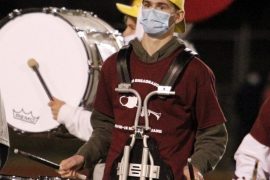Alyssa Tumolo of SRSLY Dexter recently spoke at Dexter Rotary giving an update as to the state of Dexter youth and the ongoing effort to prevent them from engaging in destructive habits. Allyssa was accompanied by Dr. Elizabeth Block MD who spoke on the effects of cannabis on the developing brain. Dr. Block’s presentation will be covered in a separate article.
SRSLY Dexter was formed in 2013 as an extension of the SRSLY program in Chelsea. The coalition’s mission is “to promote the health and well-being of Dexter youth through a community-wide initiative aimed at decreasing the onset and incidence of high-risk behaviors, including the abuse of alcohol and other drugs.” SRSLY is supported by St. Joseph Mercy Chelsea, 5 Healthy Towns, and community partners.
Alyssa opened up her presentation by saying “The good news is a majority of teens here in Dexter do not use tobacco, alcohol, or other drugs.”
The Data
The graph below shows the percentage of Dexter students who have recently used illicit substances and the percentage of students who have ever used in their lifetime. As the data shows, the percentage of Dexter students involved with substance abuse is less than half of the rest of Michigan.

The data comes from the the Michigan Profile for Healthy Youth (MiPHY), which is an online student health survey offered by the Michigan Departments of Education and Health and Human Services. The survey is conducted every two years in grades 7, 9, and 11, and provides student results on health risk behaviors including substance use, violence, physical activity, nutrition, sexual behavior, and emotional health. The MiPHY also measures risk and protective factors most associated with predicting substance abuse and violent behavior.
A big question is what impact the recent legalization of marijuana for recreational use will have on students. Marijuana use among Dexter teens has been on a steady decline since 2010 but with an upward tick in this year’s survey. “Overall we’re doing much better since 2010,” Alyssa said, “but this is an upward trend that we are monitoring.”

Recent use among 9th and 11th graders for marijuana, alcohol, prescription painkillers, tobacco, and e-cigarettes showed that the relatively new trend of vaping has become most popular. This could possibly be from a lack of perceived risk factors associated with vaping. Alcohol use remains well above marijuana and Rx drugs. This could possibly be attributed to accessibility.

Influencing Factors
“It’s important to know where the teams are getting their alcohol,” Alyssa told the Rotarians. “30.3% of high school students report alcohol being given to them. 53.8% of a students report using alcohol at their own home, and 43.1% report using alcohol at another person’s home.”
“Many factors influence a person’s chance of developing a substance abuse disorder,” Alyssa states. “Effective prevention focuses on reducing those risk factors and strengthening protective factors that are most closely related to the problem being addressed.”
Perception of use among peers and their approval has a big impact on any kid’s decision to use drugs or alcohol. One factor working as a catalyst for usage is a teen’s over-estimation of how much their peers are actually using. However, as kids get a more realistic view of what’s actually happening around them, the percentage of kids over-estimating the usage of drugs among their friends is declining. And as that declines, so does the power of that influential factor.
“There’s been a significant decrease in the perception of risk for alcohol and marijuana,” Alyssa explained. “71% of Dexter High School youth report that regular use of alcohol is a moderate risk. 57% of Dexter youth report that regular use of marijuana is a moderate to great risk.”
Protective Factors
The best preventative measures for teen substance abuse come from connection to community and family. Having a strong connection to family, friends, community and school strengthens protective factors.
A remarkable 95.7% of Dexter High School students report lots of opportunity to get involved in wholesome activities outside of school. That is a tremendous reflection on Dexter. In the schools, 89.7% of students feel able to be part of classroom discussion and activities and 89.5% of students surveyed feel there is lots of opportunity to talk with a teacher one-on-one.
When it comes to family life and the protective factors it can afford, 83% of students feel they could ask their parents for help on a personal problem. The percentage of students who feel parents do lots of fun things with them is 77%. The number of youth who enjoy spending time with their parents is 89%
All those percentages may sound wonderful, if perhaps you were taking a test, but it is important to remember that the data is still telling us that 10-20% of students are lacking significant protective factors. The absence of which exposes them to risk.
This is where we, as a community, can help out in several ways to possibly make up the difference, regardless if whether you have kids of school age or not. Some suggestions given by Alyssa are:
- Providing opportunity and mentorship in youth sports and clubs such as scouting and 4-H.
- Adults complimenting and telling youth they are proud of them.
- Neighbors and adults encouraging youth to do the best they can.
- Being a listening ear for teens if needed.
“Recognizing youth in your life with positive and encouraging words does more than you could know,” Alyssa explained. “This is noticing when a youth is doing something good and telling them that. Those positive words coming from somebody in the community are huge.”













